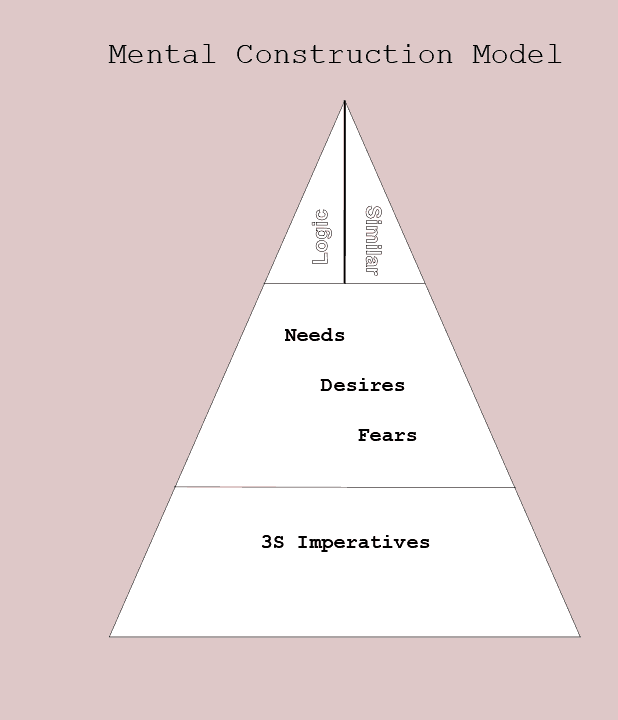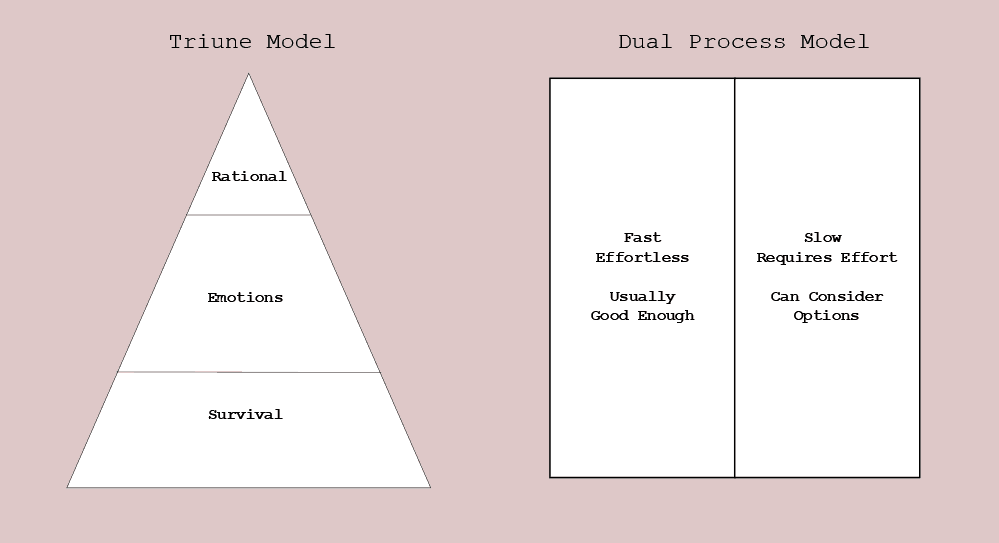Triune brain and the dual process model of thinking are the precursors of the unified Mental Construction theory.
Triune Brain
The triune brain postulates three layers of the brain working in synchronicity–the reptilian brain (survival), the old mammalian brain (emotions), and the new mammalian brain (rational). The theory was developed by Paul MacLean starting in the 1960s.The triune brain emphasizes the importance of non-conscious brain activity in determining human behavior. It developed to explain observed behavior based on then current biological understandings.
Consider the Triune Model (Figure 1 below, left half).
- The base of the triangle is concerned with survival (the reptilian brain), composed of the brainstem and the cerebellum, and provides rigid, compulsive, and reflexive behavior.
- Above the survival layer are the emotions created in the limbic layer, originating with the emergence of mammals. Its value judgements are often unconscious and may be called instinctive.
- The pinnacle of human thinking is rational thought which requires the neocortex of humans.
An important feature of the triune brain is that the rational can sometimes overrule the emotional decision which can sometimes overrule the survival decision.
The Mental Construction theory generally conforms with the three stage hierarchy. However Mental Construction develops a neural mechanism by which events are categorized and processed, based on development stage. A consequence of the neural process leads to the recognition that rational layer must be split, very like that envisioned by the Dual Process Model (in Figure 1, right half).
Dual Process Model
The dual process model asserts that two distinctively separate cognitive systems underlying thinking and reasoning. William James (p 674-675) called them associative and true reasoning. Others call the pair intuitive and logical. Keith Stanovich calls them System 1 and System 2.These dual process explanations often focus on the distinction between an unconscious and a conscious decision. Significant psychological studies support the notion that two thought strands are simultaneously occurring in our brains. Sometimes the strands are distinct as controling a car while thinking about happenings in our lives, while other times the strands compete as when immediate emotional desires lead in one direction while logical considerations warn of delayed consequences.
The dual process model got a huge boast in visibility with Daniel Kahneman’s best seller Thinking, Fast and Slow. Thinking fast is our automatic, effortless approach to understanding and reacting to events. Although it’s usually good enough, we can make mistakes using its heuristic rules. Thinking slow occurs when we decide to make an effort to think through the events, their possible sources and consequences. It is fatiguing to apply our thoughts so diligently.
The Mental Construction model (Figure 2) also accords with a dual approach, but it focuses on duality in the cortical regions of the brain. Its overarching theory of neural operations leading to mental phenomenon allows a new avenue to investigate the properties of the two systems.
Cognition:All We Can Think Preconscious, emotional, automatic, and deliberate
The Table of Contents provides a organized entry to the Mental Construction theory.


